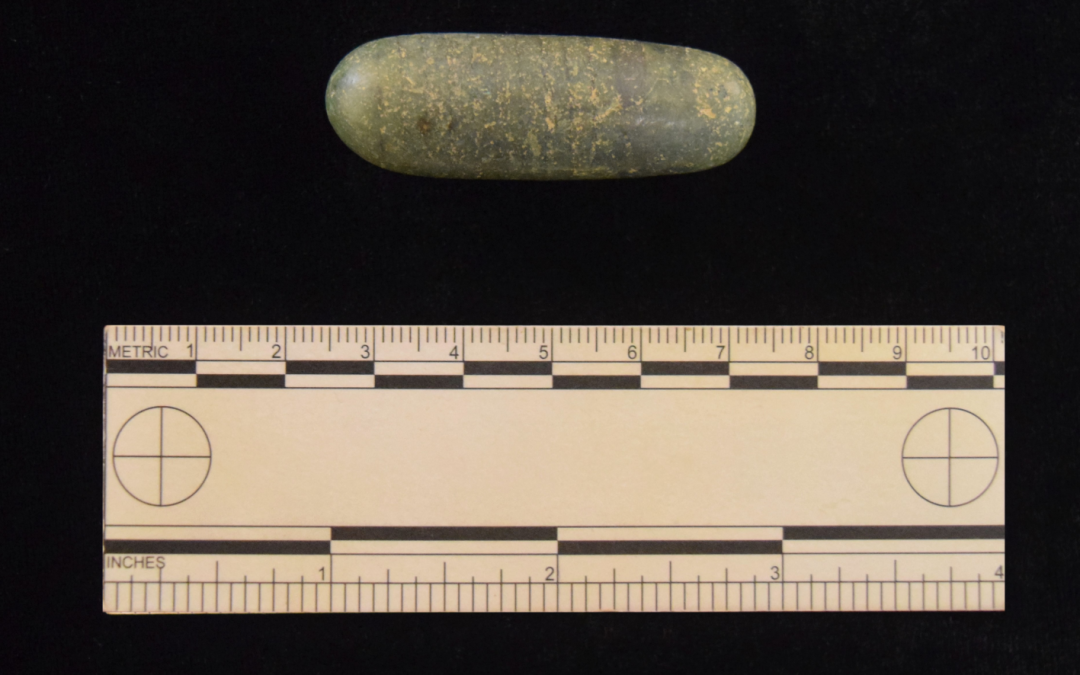,, By Bill Liebeknecht
While conducting a controlled Phase I archaeological surface collection of a precontact site in northern New Jersey for a proposed development, an unusual find was discovered: a dense, polished, cylindrical-shaped piece of chiastolite. Chiastolite is a variety of andalusite, an aluminum nesosilicate mineral. The stone measures 1.8 inches (48 mm) in length and has a diameter of 0.63 inches (16 mm). This small stone weighs a hefty 2 ounces (58 grams) and has a hardness of between 5 and 5.5 on the Mohs Hardness Scale — a density scale developed by geologists to gauge the hardness of rocks and minerals, with soft stones like talc at a 1 and very hard materials like diamonds at a 10.
When the small stone was initially found in the field, the first thoughts were that it was a lead fishing weight based on its heavy weight as the surface was obscured by mud. When it was cleaned off, however, it was quickly identified as stone. The question then became what kind of stone could weigh so much. The initial interpretation was that it was a mineralized banded fossil, believed to be peridotite. The material type remained in question, but it did appear to be a cultural item, possibly a curio or charm-like object carried by a Sachem (chief or head of a Native American tribe). These items were carried in a pouch with sand and other sacred items, which became polished over time. A similar polished cylindrical stone was found in West Windsor Township, Mercer County, New Jersey, made of graywacke and was thought to be a curio or charm.
With the permission of the landowner, the Dovetail small stone was taken to various regional conferences, where no less than 50 archaeologists have examined the specimen. At the most recent Eastern States Archaeological Federation (ESAF) conference, the specimen was once again paraded around with no concrete answers until Curtiss Hoffman of the Massachusetts Archaeological Society (ASM) asked to see the by-now-famous dense cylindrical stone. He immediately referred the author to an article that he had co-written in 1999 for the Bulletin of the ASM in which he examined a number of similar stones from Massachusetts called chiastolite. Hoffman documented where they had been found in direct and indirect association with precontact artifacts. In America, chiastolite has been found in California, New Mexico, Virginia, and Massachusetts.
Still not convinced the stone was chiastolite, the stone was destined for the next conference — and likely to a museum to be examined by a geologist. As fate would have it, a geologist later approached the author at this same ESAF event and asked to see the stone that was the talk of the conference. He immediately said it was certainly chiastolite, had been polished, and was exposed to fire as it exhibited slight magnetic qualities.
As chiastolite is not known as a natural material in New Jersey, how did it find its way to a remote farm field in the northern part of the state? The other question that remains open to interpretation is whether the artifact dates to the precontact period or to the historic period, as chiastolites were also worn as amulet or charms as early as the sixteenth century in Europe for its protective, balancing, and transformative powers and are still sought after today. Hopefully, further research — and incredibly good luck at conferences — will help shed more light on this unusual find, and help others identify these interesting artifacts elsewhere in the field.
References
Hoffman, Curtiss, Maryanne MacLeod and Alan Smith
1999 Symbols in Stone: Chiastolites in New England Archaeology. In the Bulletin of the Massachusetts Archaeological Society Volume 60(1):2–17.

